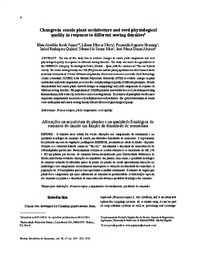Changes in canola plant architecture and seed physiological quality in response to different sowing densities.
Changes in canola plant architecture and seed physiological quality in response to different sowing densities.
Author(s): JACOB JUNIOR, E. A.; MERTZ, L. M.; HENNING, F. A.; RODRÍGUEZ QUILÓN, I.; MAIA, M. de S.; ALTISENT, J. M. D.
Summary: ABSTRACT: The aim of this study was to evaluate changes in canola yield components and seed physiological quality in response to different sowing densities. The study was made in a greenhouse at the REIPESOL Company Technological Center, Madrid – Spain, with the commercial “Toccata” hybrid variety. The initial sowing density was 360,000 plants/ha and the plant population was later thinned down to include treatments of 250 and 180 thousand plants/ha. Harvested seeds were sent to the Seed Technology Center Laboratory (CATES) at the Madrid Polytechnic University (UPM) to evaluate changes in plant architecture and yield components, as well as the seed physiological quality of different plant parts. Results demonstrated that canola plants showed changes in morphology and yield components in response to different sowing densities. The population of 250,000 plants/ha showed the best seed yield demonstrating that maximum yield is directly related to a correct sowing density. The number of pods/plant was the most important component for increased seed yield/plant and seed yield/area. The spatial distribution of canola seeds in the plant and canola sowing density did not affect seed physiological quality. RESUMO: Alterações na arquitetura de plantas e na qualidade fisiológica de sementes de canola em função da densidade de semeadura. O objetivo neste estudo foi avaliar alterações nos componentes de rendimento e na qualidade fisiológica de sementes de canola, em diferentes densidades de semeadura. O experimento foi instalado em casa-de-vegetação, na Empresa REIPESOL, localizada na cidade de Madri – Espanha. Utilizou-se a variedade hibrida comercial “Toccata”. Inicialmente a densidade de semeadura foi de 360 mil plantas por hectare. Posteriormente realizou-se o raleio obtendo-se as densidades de 360, 250 e 180 mil plantas por hectare. As sementes foram encaminhadas para Universidade Politécnica de Madri, onde foram avaliadas alterações na arquitetura das plantas, bem como, a qualidade fisiológica de sementes oriundas de diferentes partes da planta. As plantas de canola apresentaram alterações na morfologia e nos componentes do rendimento em resposta às variações na densidade de semeadura. A população de 250 mil plantas por hectare apresentou o melhor rendimento. O número de vagens por planta foi o componente que mais influenciou no aumento da produtividade. A distribuição espacial das sementes na planta e a densidade de semeadura não afetam a qualidade fisiológica das sementes.
Publication year: 2012
Types of publication: Journal article
Unit: Embrapa Soybean
Keywords: Canola, Colza, Qualidade, Seed quality, Semente
Observation
Some of Embrapa's publications are published as ePub files. To read them, use or download one of the following free software options to your computer or mobile device. Android: Google Play Books; IOS: iBooks; Windows and Linux: Calibre.
Access other publications
Access the Agricultural Research Database (BDPA) to consult Embrapa's full library collection and records.
Visit Embrapa Bookstore to purchase books and other publications sold by Embrapa.

